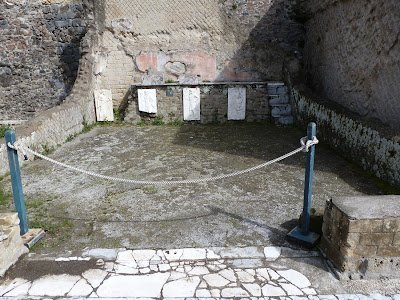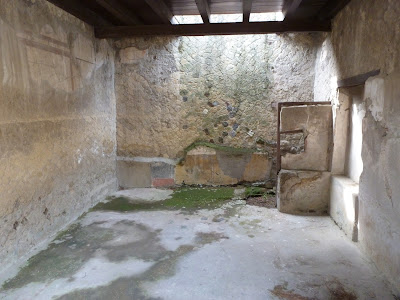Vesuvius is the only active volcano in Europe. Its most famous
eruption (in AD 79) buried the cities of Pompeii and Herculaneum, which were preserved in ash and remained virtually untouched until the 1700s.
Today, both sites are partially excavated and open for visitors. Herculaneum (present day Ercolano) is further north, along the coast. Pompeii is a bit south of Vesuvius, and slightly more inland:
Pompeii is the more famous
of the two sites, and approximately four times larger than Herculaneum. However,
Herculaneum is better preserved and less crowded, as well as very convenient to the bus that goes up to Vesuvius. We chose Herculaneum. How did we learn all that to inform our decision? We try to do our homework before we go, of course! See?
 |
| Three of us, hard at work at our hotel in Naples... |
Several sources recommended that we prepare for our trip by checking out the Museo Archeologico in Naples (which we'd done the day before), then visiting the excavations, and ending with the hike up Vesuvius. And that is precisely what we planned to do on this particular day: First tour the excavation of Herculaneum, then join a bus trip up to Vesuvius later the in afternoon, when clearer weather promised a better view.
The trip to Herculaneum (Ercolano) was remarkably easy. We had chosen our hotel in Naples for its proximity to the main train station in Naples (obviously we didn't chose it for its winning atmosphere), so we simply walked a block to the station, located the correct train, and bought our ticket. For just a few Euros, we rode ~20-25 minutes to the Ercolano- Scavii stop, then walked about six blocks straight toward the water. We found these gardens just outside the excavation site:
 |
| Gardens in Ercolano, with Vesuvius in the distance. |
Turning around 180 degrees, we could look down into the Herculaneum excavation site.
 |
Unlike the gradual build-up of land and debris we discussed in our post on Underground Rome,
in Herculaneum, the city was buried all at once under volcanic debris.
The new city of Ercolano was built on top of the debris many years
later. Herculaneum was actually discovered by someone digging a well in Ercolano...
The day was turning out to be absolutely gorgeous, warm and sunshiny, and it looked like we'd have the excavation site all to ourselves. We bought our tickets, rented an audioguide, and headed down into the excavation. From here on out, I think this trip will be best shared through photos. So let's go!
 | |
| We weren't allowed down, but this was one of the large bath areas. You can see one of the baths to the right of that pillar in the back. |
 |
| This is what remains from one of the temple alters in the city. This is one of the least well-preserved areas. But check out those steps in the back right hand corner... |
 |
| ...in a close-up. These are originals, constructed from some kind of marble. Crazy! |
Walking through the streets of this forgotten and buried city was a surreal experience - I felt immersed in a secret place, but a glance up revealed the modern day houses and apartments of Ercolano:
 |
| How long ago were these roads built? Someone still thought to put sidewalks in, though! |
Steered by our audioguide, we wandered down the street, stopping to peer into each building. The floors and walls of the ground levels were largely intact, although most were missing ceilings and upper floors (there are a few photos later in this post, though). This first street (also pictured above) was largely a commercial hub.
 |
| This is the back room of the bar, where customers could sit and eat. And do you see that little wall in the back right hand corner of the room? Yep, that was the loo! |
 |
| More amphora, held on one of the few upper levels that remained in the buildings. The wood was somehow preserved by the heat and ash of the eruption. |
There were a few other places where we found bits of this blackened wood. Kee-Min snapped a great close-up here:
Obviously, this wood is not in stellar shape. If the wood had survived better, we might see more upper levels on the buildings. I believe this one has been rebuilt as an example:
 |
| See the wooden ceiling/floor, and the wood framing in the wall on the upper level? |
Zooming in a bit might help:
Now - once you get your snack and take a break, come on back for some photos of the residential areas of Herculaneum!











